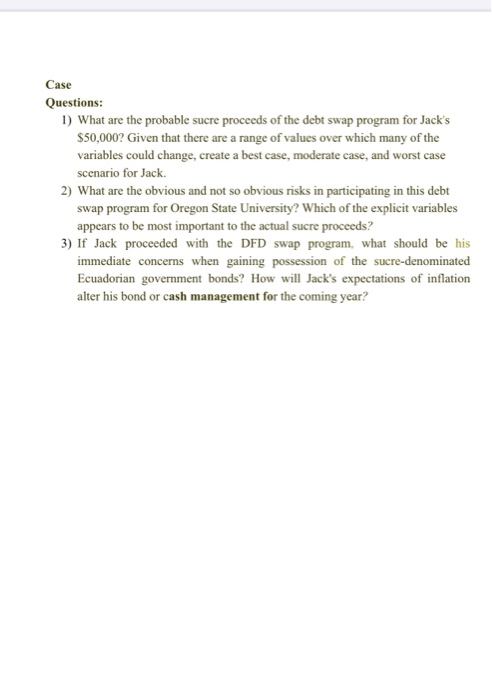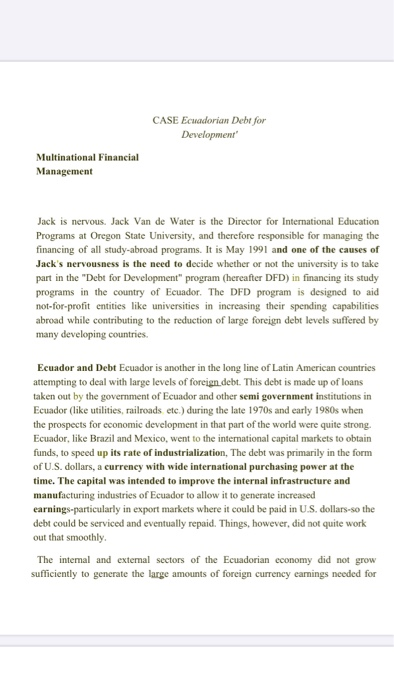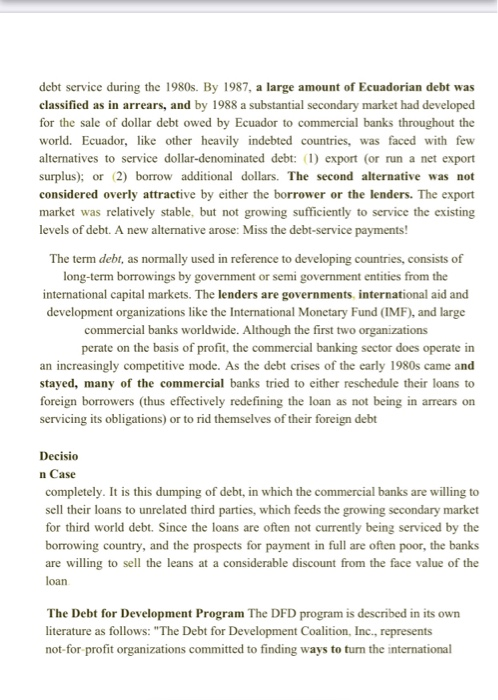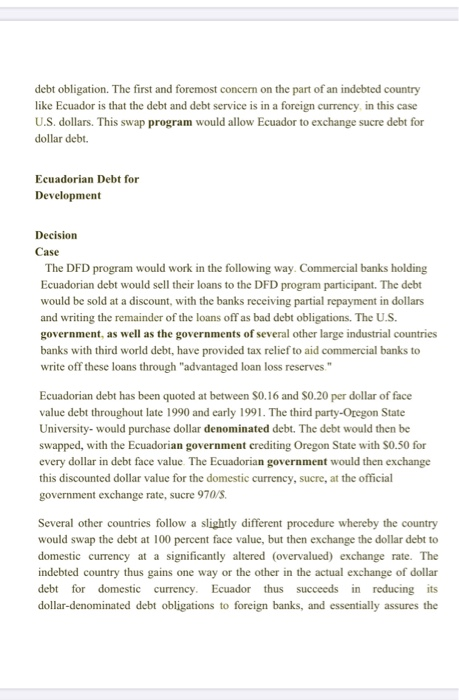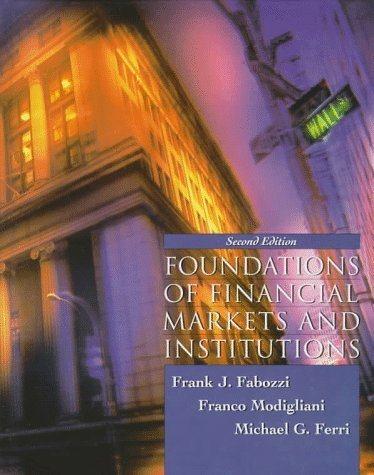Case Questions: 1) What are the probable sucre proceeds of the debt swap program for Jack's $50,000? Given that there are a range of values over which many of the variables could change, create a best case, moderate case, and worst case scenario for Jack 2) What are the obvious and not so obvious risks in participating in this debt swap program for Oregon State University? Which of the explicit variables appears to be most important to the actual sucre proceeds? 3) If Jack proceeded with the DFD swap program, what should be his immediate concerns when gaining possession of the sucre-denominated Ecuadorian government bonds? How will Jack's expectations of inflation alter his bond or cash management for the coming year? CASE Ecuadorian Debt for Development Multinational Financial Management Jack is nervous. Jack Van de Water is the Director for International Education Programs at Oregon State University, and therefore responsible for managing the financing of all study-abroad programs. It is May 1991 and one of the causes of Jack's nervousness is the need to decide whether or not the university is to take part in the "Debt for Development program (hereafter DFD) in financing its study programs in the country of Ecuador. The DFD program is designed to aid not-for-profit entities like universities in increasing their spending capabilities abroad while contributing to the reduction of large foreign debt levels suffered by many developing countries Ecuador and Debt Ecuador is another in the long line of Latin American countries attempting to deal with large levels of foreign debt. This debt is made up of loans taken out by the government of Ecuador and other semi government institutions in Ecuador (like utilities, railroads etc.) during the late 1970s and early 1980s when the prospects for economic development in that part of the world were quite strong. Ecuador, like Brazil and Mexico, went to the international capital markets to obtain funds, to speed up its rate of industrialization, The debt was primarily in the form of U.S. dollars, a currency with wide international purchasing power at the time. The capital was intended to improve the internal infrastructure and manufacturing industries of Ecuador to allow it to generate increased carnings-particularly in export markets where it could be paid in US dollars so the debt could be serviced and eventually repaid. Things, however, did not quite work out that smoothly, The internal and external sectors of the Ecuadorian cconomy did not grow sufficiently to generate the large amounts of foreign currency carnings needed for debt service during the 1980s. By 1987, a large amount of Ecuadorian debt was classified as in arrears, and by 1988 a substantial secondary market had developed for the sale of dollar debt owed by Ecuador to commercial banks throughout the world. Ecuador, like other heavily indebted countries, was faced with few alternatives to service dollar-denominated debt: 1) export (or run a net export surplus); or 2) borrow additional dollars. The second alternative was not considered overly attractive by either the borrower or the lenders. The export market was relatively stable, but not growing sufficiently to service the existing levels of debt. A new alternative arose: Miss the debt-service payments! The term debt, as normally used in reference to developing countries, consists of long-term borrowings by government or semi government entities from the international capital markets. The lenders are governments international aid and development organizations like the International Monetary Fund (IMF), and large commercial banks worldwide. Although the first two organizations perate on the basis of profit, the commercial banking sector does operate in an increasingly competitive mode. As the debt crises of the early 1980s came and stayed, many of the commercial banks tried to either reschedule their loans to foreign borrowers (thus effectively redefining the loan as not being in arrears on servicing its obligations) or to rid themselves of their foreign debt Decisio n Case completely. It is this dumping of debt, in which the commercial banks are willing to sell their loans to unrelated third parties, which feeds the growing secondary market for third world debt. Since the loans are often not currently being serviced by the borrowing country, and the prospects for payment in full are often poor, the banks are willing to sell the leans at a considerable discount from the face value of the loan The Debt for Development Program The DFD program is described in its own literature as follows: "The Debt for Development Coalition, Inc., represents not-for-profit organizations committed to finding ways to turn the international debts of countries into economic development opportunities." If a portion of the external debt of developing nations can be converted-by donation or purchase-into local currencies, not-for-profit organizations can use the funds for development projects needed to help spur economic growth in Latin America, Africa, Asia, and the Pacific. Coalition members are U.S. colleges and universities, cooperatives private volunteer organizations, and research institutes engaged in economic development programs overseas. The coalition also maintains close cooperation with various U.S. environmental organizations. The coalition works closely with private organizations in debtor nations to identify programs important to each country's economic priorities such as education, public health, nutrition, agriculture, small business enterprises, research, housing, credit, and natural resource management programs. The DFD program arose from the growing activity in what is called debt for equity swaps. Many of the indebted countries wished to alter the nature of their obligations from debt to participating equity, where the holder would see returns tied to the profits (or losses) of the enterprises associated with the capital. The idea was to encourage long-term equity involvement in the country, rather than the debt repayment at any cost posture of most debt holders. The Debt for Development swap is something akin to a debt for equity swap. The dollar debt is swapped for sucre denominated debt in this case, however, rather than into the equity ownership of a sucre-denominated enterprise. Most debt holders have traditionally opposed debt redenomination schemes due to the weakness and inconvertibility of many of the developing country currencies. A country heavily indebted in dollars might reissue all debt in its own currency, essentially printing money to repay the debt. This is commonly thought to be too dangerous for all parties, resulting in depreciated values in repayment and inducing the country to undertake inflationary policies not in its own best interest. The DFD program however, altered this process substantially by limiting the actual sucre to be swapped and by requiring a debt swap with a repayment schedule matching that of the initial debt obligation. The first and foremost concern on the part of an indebted country like Ecuador is that the debt and debt service is in a foreign currency in this case U.S. dollars. This swap program would allow Ecuador to exchange sucre debt for dollar debt. Ecuadorian Debt for Development Decision Case The DFD program would work in the following way. Commercial banks holding Ecuadorian debt would sell their loans to the DFD program participant. The debt would be sold at a discount, with the banks receiving partial repayment in dollars and writing the remainder of the loans off as bad debt obligations. The U.S. government, as well as the governments of several other large industrial countries banks with third world debt, have provided tax relief to aid commercial banks to write off these loans through "advantaged loan loss reserves Ecuadorian debt has been quoted at between $0.16 and $0.20 per dollar of face value debt throughout late 1990 and early 1991. The third party-Oregon State University-would purchase dollar denominated debt. The debt would then be swapped, with the Ecuadorian government crediting Oregon State with S0.50 for every dollar in debt face value. The Ecuadorian government would then exchange this discounted dollar value for the domestic currency, sucre, at the official government exchange rate, sucre 970/S. Several other countries follow a slightly different procedure whereby the country would swap the debt at 100 percent face value, but then exchange the dollar debt to domestic currency at a significantly altered (overvalued) exchange rate. The indebted country thus gains one way or the other in the actual exchange of dollar debt for domestic currency. Ecuador thus succeeds in reducing its dollar-denominated debt obligations to foreign banks, and essentially assures the proceeds of the conversion will be spent in the domestic economy (sucre do not buy anything anywhere else)! There is, however, a final twist to this specific program. Ecuador, although anxious to retire or replace existing dollar-denominated debt with domestic currency does not wish to add to inflationary pressures by pumping up its money supply. The government of Ecuador therefore will swap the debt as described, but for sucre-denominated bonds, not cash. These bonds would then be serviced by sucre-denominated cash flows (coupons) to be paid quarterly until maturity on October 31, 1996. The payment schedule and maturity matches the schedules of the original debt. This last feature poses a problem for Jack (he is to the point of facial "ticks" now; twitching). Given the limited resources a university possesses in conducting study-abroad programs, he needs all the sucre value possible for use in the current period. Jack inquires as to the liquidity of these government bonds, and is told the market is "thin," but the bonds will likely be able to be sold at discounts ranging from 10 to 30% depending on financial and inflationary conditions. Jack's Dilemma Jack was now running short of time. He had to decide whether to commit his resources and his study abroad program financing, approximately $50,000 for the 1991-1992 academic year, to the DFD program or not. Jack then summarized the major points he needed to weigh in the pro and con columns of the dog-eared Big Chief tablet on his desk. Case Questions: 1) What are the probable sucre proceeds of the debt swap program for Jack's $50,000? Given that there are a range of values over which many of the variables could change, create a best case, moderate case, and worst case scenario for Jack 2) What are the obvious and not so obvious risks in participating in this debt swap program for Oregon State University? Which of the explicit variables appears to be most important to the actual sucre proceeds? 3) If Jack proceeded with the DFD swap program, what should be his immediate concerns when gaining possession of the sucre-denominated Ecuadorian government bonds? How will Jack's expectations of inflation alter his bond or cash management for the coming year? CASE Ecuadorian Debt for Development Multinational Financial Management Jack is nervous. Jack Van de Water is the Director for International Education Programs at Oregon State University, and therefore responsible for managing the financing of all study-abroad programs. It is May 1991 and one of the causes of Jack's nervousness is the need to decide whether or not the university is to take part in the "Debt for Development program (hereafter DFD) in financing its study programs in the country of Ecuador. The DFD program is designed to aid not-for-profit entities like universities in increasing their spending capabilities abroad while contributing to the reduction of large foreign debt levels suffered by many developing countries Ecuador and Debt Ecuador is another in the long line of Latin American countries attempting to deal with large levels of foreign debt. This debt is made up of loans taken out by the government of Ecuador and other semi government institutions in Ecuador (like utilities, railroads etc.) during the late 1970s and early 1980s when the prospects for economic development in that part of the world were quite strong. Ecuador, like Brazil and Mexico, went to the international capital markets to obtain funds, to speed up its rate of industrialization, The debt was primarily in the form of U.S. dollars, a currency with wide international purchasing power at the time. The capital was intended to improve the internal infrastructure and manufacturing industries of Ecuador to allow it to generate increased carnings-particularly in export markets where it could be paid in US dollars so the debt could be serviced and eventually repaid. Things, however, did not quite work out that smoothly, The internal and external sectors of the Ecuadorian cconomy did not grow sufficiently to generate the large amounts of foreign currency carnings needed for debt service during the 1980s. By 1987, a large amount of Ecuadorian debt was classified as in arrears, and by 1988 a substantial secondary market had developed for the sale of dollar debt owed by Ecuador to commercial banks throughout the world. Ecuador, like other heavily indebted countries, was faced with few alternatives to service dollar-denominated debt: 1) export (or run a net export surplus); or 2) borrow additional dollars. The second alternative was not considered overly attractive by either the borrower or the lenders. The export market was relatively stable, but not growing sufficiently to service the existing levels of debt. A new alternative arose: Miss the debt-service payments! The term debt, as normally used in reference to developing countries, consists of long-term borrowings by government or semi government entities from the international capital markets. The lenders are governments international aid and development organizations like the International Monetary Fund (IMF), and large commercial banks worldwide. Although the first two organizations perate on the basis of profit, the commercial banking sector does operate in an increasingly competitive mode. As the debt crises of the early 1980s came and stayed, many of the commercial banks tried to either reschedule their loans to foreign borrowers (thus effectively redefining the loan as not being in arrears on servicing its obligations) or to rid themselves of their foreign debt Decisio n Case completely. It is this dumping of debt, in which the commercial banks are willing to sell their loans to unrelated third parties, which feeds the growing secondary market for third world debt. Since the loans are often not currently being serviced by the borrowing country, and the prospects for payment in full are often poor, the banks are willing to sell the leans at a considerable discount from the face value of the loan The Debt for Development Program The DFD program is described in its own literature as follows: "The Debt for Development Coalition, Inc., represents not-for-profit organizations committed to finding ways to turn the international debts of countries into economic development opportunities." If a portion of the external debt of developing nations can be converted-by donation or purchase-into local currencies, not-for-profit organizations can use the funds for development projects needed to help spur economic growth in Latin America, Africa, Asia, and the Pacific. Coalition members are U.S. colleges and universities, cooperatives private volunteer organizations, and research institutes engaged in economic development programs overseas. The coalition also maintains close cooperation with various U.S. environmental organizations. The coalition works closely with private organizations in debtor nations to identify programs important to each country's economic priorities such as education, public health, nutrition, agriculture, small business enterprises, research, housing, credit, and natural resource management programs. The DFD program arose from the growing activity in what is called debt for equity swaps. Many of the indebted countries wished to alter the nature of their obligations from debt to participating equity, where the holder would see returns tied to the profits (or losses) of the enterprises associated with the capital. The idea was to encourage long-term equity involvement in the country, rather than the debt repayment at any cost posture of most debt holders. The Debt for Development swap is something akin to a debt for equity swap. The dollar debt is swapped for sucre denominated debt in this case, however, rather than into the equity ownership of a sucre-denominated enterprise. Most debt holders have traditionally opposed debt redenomination schemes due to the weakness and inconvertibility of many of the developing country currencies. A country heavily indebted in dollars might reissue all debt in its own currency, essentially printing money to repay the debt. This is commonly thought to be too dangerous for all parties, resulting in depreciated values in repayment and inducing the country to undertake inflationary policies not in its own best interest. The DFD program however, altered this process substantially by limiting the actual sucre to be swapped and by requiring a debt swap with a repayment schedule matching that of the initial debt obligation. The first and foremost concern on the part of an indebted country like Ecuador is that the debt and debt service is in a foreign currency in this case U.S. dollars. This swap program would allow Ecuador to exchange sucre debt for dollar debt. Ecuadorian Debt for Development Decision Case The DFD program would work in the following way. Commercial banks holding Ecuadorian debt would sell their loans to the DFD program participant. The debt would be sold at a discount, with the banks receiving partial repayment in dollars and writing the remainder of the loans off as bad debt obligations. The U.S. government, as well as the governments of several other large industrial countries banks with third world debt, have provided tax relief to aid commercial banks to write off these loans through "advantaged loan loss reserves Ecuadorian debt has been quoted at between $0.16 and $0.20 per dollar of face value debt throughout late 1990 and early 1991. The third party-Oregon State University-would purchase dollar denominated debt. The debt would then be swapped, with the Ecuadorian government crediting Oregon State with S0.50 for every dollar in debt face value. The Ecuadorian government would then exchange this discounted dollar value for the domestic currency, sucre, at the official government exchange rate, sucre 970/S. Several other countries follow a slightly different procedure whereby the country would swap the debt at 100 percent face value, but then exchange the dollar debt to domestic currency at a significantly altered (overvalued) exchange rate. The indebted country thus gains one way or the other in the actual exchange of dollar debt for domestic currency. Ecuador thus succeeds in reducing its dollar-denominated debt obligations to foreign banks, and essentially assures the proceeds of the conversion will be spent in the domestic economy (sucre do not buy anything anywhere else)! There is, however, a final twist to this specific program. Ecuador, although anxious to retire or replace existing dollar-denominated debt with domestic currency does not wish to add to inflationary pressures by pumping up its money supply. The government of Ecuador therefore will swap the debt as described, but for sucre-denominated bonds, not cash. These bonds would then be serviced by sucre-denominated cash flows (coupons) to be paid quarterly until maturity on October 31, 1996. The payment schedule and maturity matches the schedules of the original debt. This last feature poses a problem for Jack (he is to the point of facial "ticks" now; twitching). Given the limited resources a university possesses in conducting study-abroad programs, he needs all the sucre value possible for use in the current period. Jack inquires as to the liquidity of these government bonds, and is told the market is "thin," but the bonds will likely be able to be sold at discounts ranging from 10 to 30% depending on financial and inflationary conditions. Jack's Dilemma Jack was now running short of time. He had to decide whether to commit his resources and his study abroad program financing, approximately $50,000 for the 1991-1992 academic year, to the DFD program or not. Jack then summarized the major points he needed to weigh in the pro and con columns of the dog-eared Big Chief tablet on his desk
